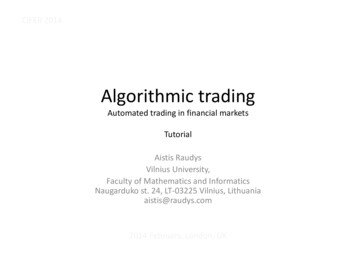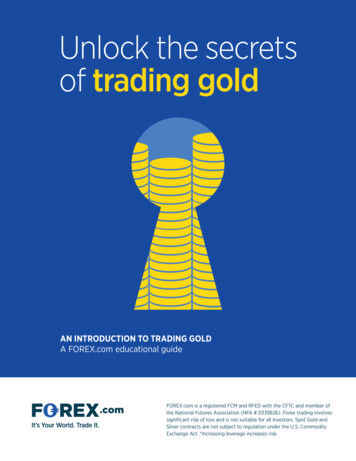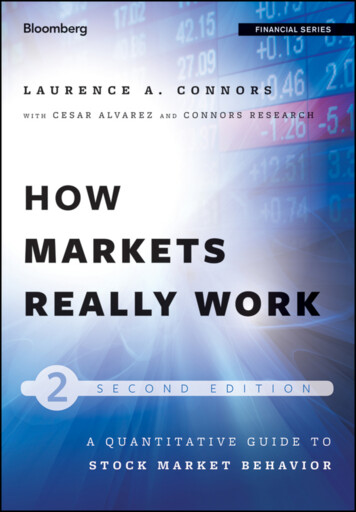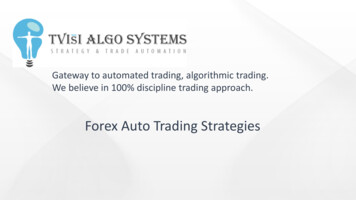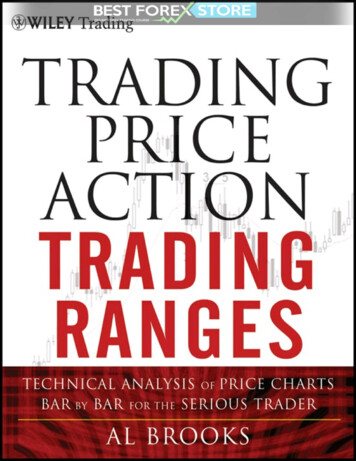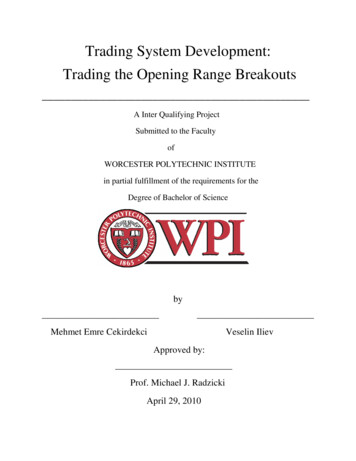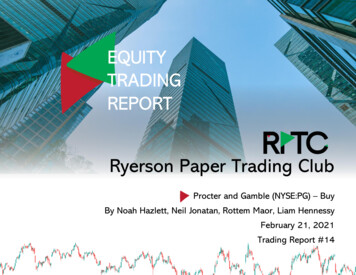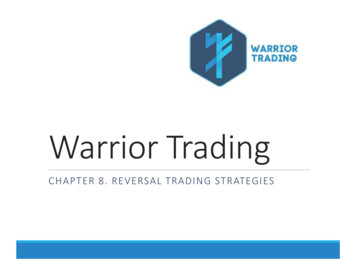
Transcription
An Introductionto Tradingin the FinancialMarkets Trading, Markets,Instruments, andProcessesR. “Tee” WilliamsAMSTERDAM BOSTON HEIDELBERG LONDONNEW YORK OXFORD PARIS SAN DIEGOSAN FRANCISCO SINGAPORE SYDNEY TOKYOAcademic Press is an imprint of Elsevier
Academic Press is an imprint of Elsevier30 Corporate Drive, Suite 400, Burlington, MA 01803, USA525 B Street, Suite 1900, San Diego, California 92101-4495, USAThe Boulevard, Langford Lane, Kidlington, Oxford 0X5 1GB, UKCopyright 2011 Elsevier Inc. All rights reserved.All illustrations 2011 R. “Tee” Williams. All rights reserved.No part of this publication may be reproduced or transmitted in any form or by any means,electronic or mechanical, including photocopying, recording, or any information storage andretrieval system, without permission in writing from the publisher. Details on how to seekpermission, further information about the Publisher's permissions policies and our arrangementswith organizations such as the Copyright Clearance Center and the Copyright Licensing Agency,can be found at our website: www.elsevier.com/permissions.This book and the individual contributions contained in it are protected under copyright by thePublisher (other than as may be noted herein).NoticesKnowledge and best practice in this field are constantly changing. As new research and experiencebroaden our understanding, changes in research methods, professional practices, or medicaltreatment may become necessary.Practitioners and researchers must always rely on their own experience and knowledge inevaluating and using any information, methods, compounds, or experiments described herein. Inusing such information or methods they should be mindful of their own safety and the safety ofothers, including parties for whom they have a professional responsibility.To the fullest extent of the law, neither the Publisher nor the authors, contributors, or editors,assume any liability for any injury and/or damage to persons or property as a matter of productsliability, negligence or otherwise, or from any use or operation of any methods, products,instructions, or ideas contained in the material herein.Library of Congress Cataloging-in-Publication DataWilliams, R. Tee.An introduction to trading in the financial markets : trading, markets,instruments, and processes / R. “Tee” Williams.p. cm.Includes bibliographical references and index.ISBN 978-0-12-374839-31. Capital market. 2. Stock exchange. 3. Financial instruments. I. Title.HG4523.W5553 2011332'.0415–dc222010039627Set ISBN: 978-0-12-384972-4British Library Cataloguing-in-Publication DataA catalogue record for this book is available from the British Library.For information on all Academic Press publicationsvisit our Web site at www.elsevierdirect.comPrinted in China11 12 13 141510987654321
ContentsPreface for the SetvPrefacexviiOverviewxixVisual GlossaryPart 1: Investing and TradingChapter 1: InvestingChapter 2: TradingPart 2: Markets and MarketplacesChapter 1: The Primary MarketChapter 2: Secondary MarketsPart 3: InstrumentsChapter 1: Cash InstrumentsChapter 2: Derivative InstrumentsPart 4: ProcessesChapter 1: Primary Market ProcessChapter 2: Secondary Market ProcessChapter 3: Support iii
Preface for the SetThe four books in the set are an exercise in reportage. Throughout my career,I have been primarily a consultant blessed with a wide array of projects for manydifferent kinds of entities in Africa, Asia, Europe, and North America. I have not been apractitioner but rather a close observer synthesizing the views of many practitioners.Although these books describe trading and the technology that supports trading,I have never written an order ticket or line of computer code in anger.The purpose of these books is to describe what individuals and entities in thetrading markets do. Bob Simon of 60 Minutes once famously asked two founders ofthe dot-com consulting firm Razorfish to describe what they did when they got to workeach day and took off their coats. That is the purpose of these books: to examine whatparticipants in the trading markets do each day when they take off their coats. Thesebooks do not attempt to prescribe what should occur or proscribe what should not.The nature of the source material for these books is broad observation.In teaching professional development courses over nearly two decades, I havefound that both those new to the markets and even those who have been marketparticipants for years become experts in their specific area of activity; however, theylack the context to understand how their tasks fit into the overall industry. The goal ofthis set of books is to provide that context.Most consulting projects in which I have participated have required interviewswith people working in all phases of the trading markets about what they do andtheir views on how the markets work. Those views and opinions helped frame myunderstanding of the structure of the markets and the roles of its participants. I drawon those views, but I cannot begin to document all the exact sources.I have isolated fun stories I have heard along the way, which I cannot attributeto a specific source, into boxes within the text. These boxes also include asides that arerelated to the subjects being discussed but that do not specifically fit into the flow.The structure of the books presents information in a hierarchical form that putsentities, instruments, functions, technology, and processes into a framework. Categorizinginformation into hierarchies helps us understand the subject matter better and gives us aframework in which to view and understand new information. The frameworks also helpus understand how parts relate to the whole. However, my experience as a consultant convinces me that while well-chosen frameworks can be helpful and appealing tothose first coming to understand new subject matter, they also carry the risk that theirperspective may mask other important information about the subjects being categorized. So for those who read these books and want to believe that the trading marketsfit neatly into the frameworks presented here: “Yes,” I said. “Isn't it pretty to think so.”11Ernest Hemingway. The Sun Also Rises, 1926, New York: Charles Scribner’s Sons (Scribner).v
viPREFACE FOR THE SETFEATURES OF THE BOOKSFigure FM.1 shows the books in this set with tabs on the side for each of the majorsections in the book. The graphic is presented at the end of each major part of thebooks with enlarged tabs for the section just covered, with arrows pointing to thePart 1: EntitiesPart 2: InstrumentsPart 3: MarketsPart 4: FunctionsPart 5: Systems, Data, and NetworksPart 6: Global MarketsPart 7: RiskPart 8: RegulationBOOK 1Part 1: Investing and TradingBackgroundPart 2: MarketsPart 1: SystemsPart 2: DataPart 3: InstrumentsPart 3: NetworksPart 4: ProcessesPart 4: ProcessesBOOK 2BOOK 3Part 1: Global MarketsPart 2: RegulationPart 3: RiskPart 4: CompliancePart 5: Playing the GameBOOK 4Figure FM.1 The books of this set are organized as a whole and concepts are distributed so that theybuild from book to book.
FEATURES OF THE BOOKSparts of other books and within the same book where other attributes of the sametopic are addressed. I call this the “Moses Approach.”2In addition to words and graphics, the four books use color to present information, asshown in Figure FM.2. Throughout, the following color scheme represents the entities as well as functions, processes, systems, data, and networks associated withthem.Buy Side (institutional investor, retail customer, day trader)Sell Side (broker/dealers, retail branch)Bank (blue stroke buy side)Bank (red stroke sell side)Markets (trading venue)Clearing CorporationDepositoryNonfinancial FirmRegulatorVendorFigure FM.2 Color in these books identifies entities that are central to the trading markets, and alsoidentifies the functions and processes that are associated with those entities.A frustration of writing about the trading markets is the wealth of colorful anddescriptive terms that permeate the markets. These terms are helpful in describing whathappens in markets or where people work, but there is no accepted source that definesterms in everyday usage with precision. Good examples of this problem are the meaning and spellings of the terms “front office,” “middle office” and “backoffice.”3 SimilarlyI use “indices” to mean a collection of individual instances of a single index. (For exampleclosing indices—that is, values—of the Dow Jones Industrial Average on January 2, 3,and 4.) I use “indexes” to mean a collection of different copyrighted information productsmeasuring market performance (e.g., the Dow Jones, FTSE, and DAX indexes).I have elected to define the terms, as I understand them, within the books.The first instance of words appear in bold italics, which relate to definitions in theGlossary at the end of each one. The books use more hyphenated adjectives than2 You may remember from the Bible that God took Moses up on the mountain and, in addition to giving him the TenCommandments, showed Moses the Promised Land. This seems to be a good approach to organizing information. Ifyou expect people to wander in the wilderness of your prose, you at least owe them a glimpse of where they are going.3 I separate “front” and “middle” from “office” and combine “backoffice.” I believe that “backoffice” is a widelyused term throughout the economy, whereas “front office” and more particularly “middle office” are nonce termsthat may not migrate into common usage beyond the trading markets.vii
viiiPREFACE FOR THE SETnormal usage would require. I believe it is important to remove all doubt that the term“market-data systems” refers to systems for handling market data, not data systemsused by a market.The books in this set contain a large number of graphics. The goal of themis to provide more than decoration. For many people, graphics help them understandthe concepts described in the text. Most of them illustrate process flows, relationships, or characteristics of market behavior. There is neither tabular data nor URLsfrom websites here. Both are likely to be too dated by the time the books are shippedfrom the publisher to you to provide any real value.The graphics (and text) build from book to book. For example, in Part 1 ofBook 1 the graphic in Figure FM.3 describing institutional investors appears. It olioRIPLifePropertyand ersInstitutionalInvestorsTrustCompaniesPLAY BILLA TRADE F O RA LL R E A S O N SHedgeFundsR o le sBuy-Sid e FirmPurpose:— Direct investorProvider of:— InvestmentservicesConsumer of:— IntermediaryservicesFigure FM.3 Institutional investors are introduced as important buy-side entities in Figure 1.1.34 of Book 1.4 The figure numbers indicate that this is the third figure of the first category (buy side) of the first part (entities).All figure numbers follow this pattern.
FEATURES OF THE BOOKSRevenues PaymentsJ.P. Morgan & Co.21 Wall St.New York, NY 20015Date 29 October, 1929Tee Williams Associates 1,000,000.00Pay to the order ofOne Million & 00/100DollarsLa Rive Gauche & Co.24 Rue MontorguellArr. #1Paris, France123456789J. Pierpont Morgan123456789FromTo Investment fees— Assets-undermanagement fees— Investmentperformance fees— Product fees— Accountmaintenance fees— General partnerparticipation— Float (indirect) Trading (customer paid)— Commissions— Spreads— Assets-undermanagement fees— Float (indirect) Investment-related fees(may be paid by customer)— Research fees— Information— Analytical services Business expenses (paid byfirm)— Salaries— Infrastructure and otherbusiness costs— Investment-related fees(not paid by customer)Institutional InvestorsFigure FM.4 Institutional investor business models —revenues and expenses—are illustrated in Book 1,Figure 1.1.3.7.the customers, the suppliers, and the products and services for institutional investors. (Subsequent sections describe types of institutional investors based on how theyare regulated or the service they perform.)At the end of each entity subsection, the entity's core business model andwhat services it purchases from vendors and other providers are explained (seeFigure FM.4).Part 4 of Book 1 describes the functions performed by buy-side traderswho work in institutional-investor firms (see Figure FM.5). The figure illustrates whattasks the buy-side trader performs (i.e., which other functions), who the buy-sidetrader serves, which external entities interact with the buy-side trader, and whichother functions provide services to the buy-side trader.Book 2, Part 4, describes the secondary market trading process. The second step in the trading process describes the initial role that the buy-side trader playsin trading.ix
xPREFACE FOR THE SETServicesServiced lBuy-SideTraderPortfolioManagerTo DoSecuritiesMovementand ControlManage ordersChoose roleTechnologyPick intermediaryGive InstructionsSelect market(s)Set price targetFigure FM.5 Buy-side traders manage trade execution within institutional investors and their functionsare detailed in Figure 4.1.2.1 of Book 1.Figure FM.6 presents the inputs to and outputs from the buy-side tradingprocess as well as the primary focus of the buy-side trader and the decisions thatthe person must confront. Subsequent graphics in that section examine some of thedecisions and alternatives in more detail.Book 3 returns to the buy-side trader to understand the role of technologyin the process. Part 4 of that book examines the systems, data, and networks thatsupport buy-side trading.Figure 4.3.2.2 in Book 3 (Figure FM.7, see page xii) shows the systems,data, and networks that support buy-side trading. The text identifies applicationssupplied by both internal and ext
Although these books describe trading and the technology that supports trading, I have never written an order ticket or line of computer code in anger. The purpose of these books is to describe what individuals and entities in the trading markets do. Bob Simon of 60 Minutes once famously asked two founders of
